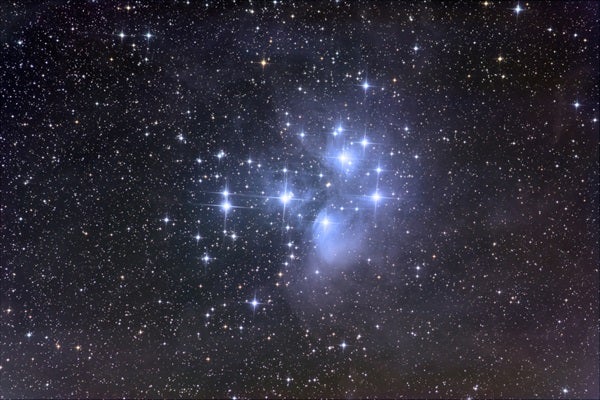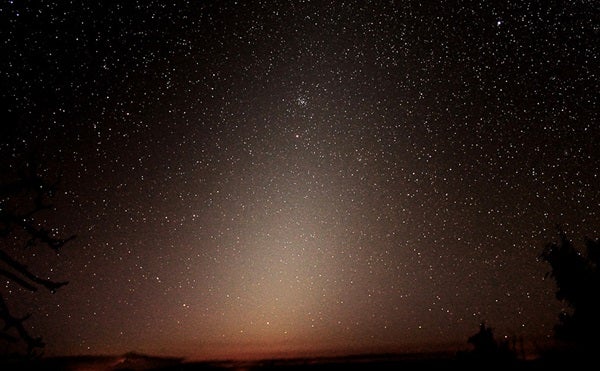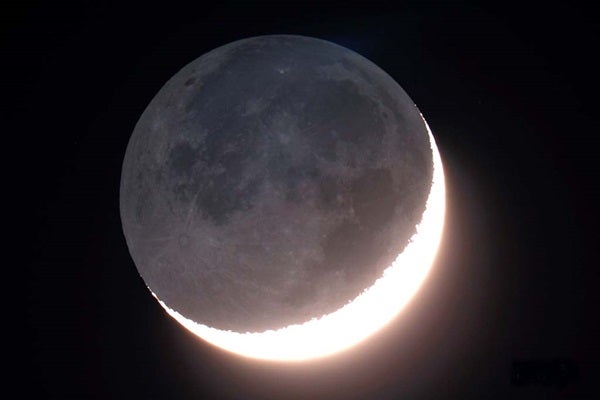Mars continues its impressive evening run as March bleeds into April. The Red Planet appears 30° high in the west once twilight fades to darkness and doesn’t set until after 11 p.m. local daylight time. The ruddy world shines at magnitude 1.4 against the backdrop of Taurus the Bull. It appears 3° south of the beautiful Pleiades star cluster (M45) tonight and tomorrow night and will remain within the same binocular field as the cluster through next weekend. The planet’s ruddy hue provides a nice contrast to the Pleiades’ blue-white stars. Unfortunately, a telescope shows little if any detail on Mars’ 5″-diameter disk.
Saturday, March 30
Mercury returns to view before dawn this week, but you’ll likely need binoculars to spot it against the twilight glow. The innermost planet shines at 1st magnitude and climbs 4° above the eastern horizon 30 minutes before sunrise. The easiest way to find it is to center on Venus and then scan to the lower left, toward where twilight glows brightest. If you turn a telescope on Mercury, you’ll see a 10″-diameter disk that appears one-quarter lit.
This week offers Northern Hemisphere observers their last good chance of 2019 to see the zodiacal light after sunset. Early spring is the best time to observe this elusive glow because it concentrates along the ecliptic — the apparent path of the Sun and planets across our sky — and this plane makes a steep angle to the western horizon in early evening at this time of year. The zodiacal light appears slightly fainter than the Milky Way, so you’ll need a clear moonless sky and an observing site located far from the city. The Moon remains out of the evening sky through April 6. Look for the cone-shaped glow, which has a broad base and points nearly straight up from the horizon, after the last vestiges of twilight have faded away.
The Moon reaches apogee, the farthest point in its orbit around Earth, at 8:14 p.m. EDT. It then lies 252,014 miles (405,577 kilometers) from Earth’s center.
Monday, April 1
Shortly after morning twilight begins, look low in the east-southeast for Venus. The planet shines brilliantly at magnitude –3.9 and pierces the growing twilight with ease. This morning, the inner world rises about 10 minutes after and nearly 10° to the left of the waning crescent Moon. A half-hour before sunrise, the two stand 10° above the horizon. Tomorrow morning, an even slimmer crescent Moon hangs 4° directly below Venus. When viewed through a telescope this week, the planet shows a disk that appears 13″ across and about 80 percent lit.
Tuesday, April 2
Jupiter continues to grow more prominent before dawn. The giant planet rises shortly after 1 a.m. local daylight time and climbs 30° high in the south an hour before sunup. It also shines at magnitude –2.3, making it the brightest point of light in the morning sky until Venus rises around 5:30 a.m. A telescope reveals at least two conspicuous cloud belts on Jupiter’s 40″-diameter disk. And this morning, the planet sports a “black eye” as the shadow of its moon Io crosses the disk. Any telescope will show the inky black spot of this volcanically active satellite as it moves from east to west across the bright cloud tops. The shadow transit begins at 3:25 a.m. EDT and runs until 5:36 a.m. Io itself crosses the jovian disk from 4:38 to 6:48 a.m. Any telescope will provide an excellent view of these transits.
Wednesday, April 3
A pair of fine binocular objects shows up nicely on evenings this week. The open star clusters M46 and M47 reside about a degree apart in the northwestern corner of the constellation Puppis the Stern. The two lie about 12° east-northeast of the night sky’s brightest star, Sirius. The western cluster, M47, glows at 4th magnitude and appears as a fuzzy patch sprinkled with several pinpoint stars. Sixth-magnitude M46 shows up as a hazy collection of faint stars that is hard to resolve under most conditions. Although it contains nearly twice as many stars as M47, M46 appears fainter and fuzzier because it lies some three times farther from Earth.
Thursday, April 4
Asteroid 2 Pallas puts on an impressive show during April. This member of the main asteroid belt glows at 8th magnitude and should be relatively easy to spot with binoculars and a cinch to see through a telescope of any size if you know where to look. And right now, the night sky’s fourth-brightest star (and the second-brightest visible from mid-northern latitudes) points the way. Magnitude 0.0 Arcturus in Boötes the Herdsman stands high in the east during late evening. (Follow the arc of the Big Dipper’s handle to locate it.) Pallas lies 5° west-southwest of this star.
Friday, April 5
New Moon occurs at 4:50 a.m. EDT. At its New phase, the Moon crosses the sky with the Sun and so remains hidden in our star’s glare.
Although the calendar may say it’s spring, the so-called Winter Hexagon remains prominent on April evenings. One of the sky’s largest asterisms — a recognizable pattern of stars separate from a constellation’s form — the hexagon stands out in the southwestern sky after darkness falls. To trace this asterism, start with southern Orion’s luminary, Rigel. From there, the hexagon makes a clockwise loop. The second stop is brilliant Sirius in Canis Major. Next, pick up Procyon in the faint constellation Canis Minor, then the twins Castor and Pollux in Gemini, followed by Capella in Auriga, Aldebaran in Taurus, and finally back to Rigel.
With an age of 4.5 billion years, “young” might not seem an appropriate word to describe our Moon. But tonight, you have an exceptional opportunity to see what astronomers call a “young Moon” — a slender crescent visible in the early evening sky. With New Moon having occurred yesterday morning, only 3 percent of our satellite’s disk appears illuminated after sunset tonight. (Tomorrow evening, a 7-percent-lit lunar crescent hangs noticeably higher in the sky.) You should notice an ashen light faintly illuminating the Moon’s dark side. This is “earthshine,” sunlight reflected by Earth that reaches the Moon and then reflects back to our waiting eyes.
Sunday, April 7
Saturn grows more conspicuous in the morning sky with each passing week. The ringed planet rises before 3 a.m. local daylight time and climbs 20° above the southeastern horizon by the time twilight begins. Saturn shines at magnitude 0.6 and appears significantly brighter than any of the background stars in its host constellation, Sagittarius the Archer. A telescope shows the gas giant’s 17″-diameter disk and a spectacular ring system that spans 37″ and tilts 24° to our line of sight.












